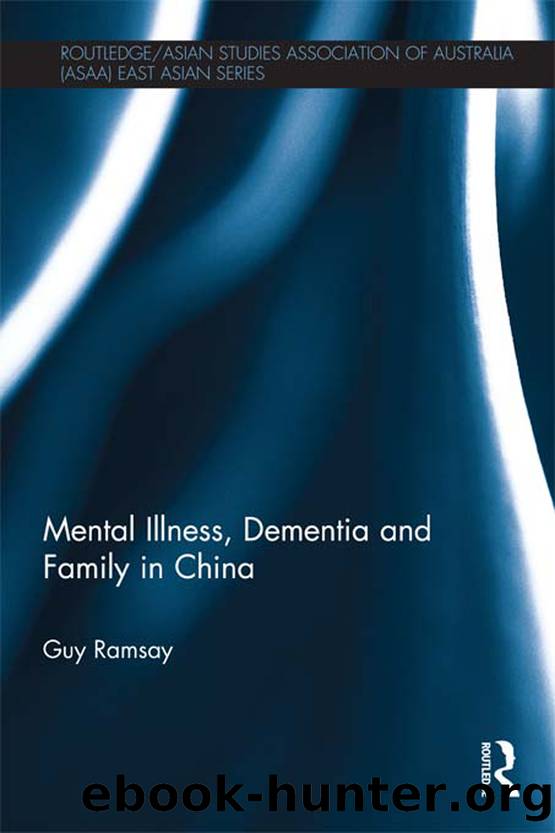Mental Illness, Dementia and Family in China by Ramsay Guy;

Author:Ramsay, Guy;
Language: eng
Format: epub
Publisher: Taylor & Francis Group
Conclusion
Analysis of the filmic stories of the experiences of people with a mental illness has documented how culture shapes the temporal and causal ordering of life events, the identities claimed and refashioned, and the language used in the stories. Mental illness is portrayed as present from birth and deteriorating over time. It results in normative gender roles being sought out but not sustained. The only identity that is sustainable for the person with a mental illness is one of stigmatised âotherâ (Harper 2004). Family caregivers remain peripheral to the stories in question but, where depicted, seek to effect control, as recounted in the life stories analysed in Chapter 3.
Both of the films under study draw on the prevailing meta-narrative of mental illness circulating in Chinese communities which devalues and stigmatises people with a mental illness. In this meta-narrative, people with a mental illness are seen as erratic, transgressive and threatening. The meta-narrative maintains that mental illness is hereditary and pollutes family lines. There is no hope for people with a mental illness. The nature of this meta-narrative and of gender scripts in Chinese culture, it is argued, results in little chance of a âsympatheticâ or âcommonplaceâ account of a Chinese woman with a mental illness being portrayed. Such a portrayal may be viable in Chinese filmic stories of men with a mental illness (Knight 2006) and in Western filmic stories of women with a mental illness (Chouinard 2009).
The negative portrayal of people with a mental illness in the films occurs regardless of the gender of the film director or her or his âgenerationalâ label. This highlights the strength of cultural resonance of the meta-narrative, drawn on in their films to critique contemporary urban life and society in mainland China. Negative and backward-looking portrayals of people with a mental illness, needless to say, also characterise Western films (Birch 2012; Chouinard 2009; Fuery 2003; Wedding et al. 2005). The analysis undertaken in the current chapter, nevertheless, identifies the ways in which such a portrayal in the Chinese films is culturally shaped (Bhugra 2006).
In sum, this chapterâs analysis of films about people with a mental illness complements the analysis of life stories of mental illness undertaken in Chapters 2 and 3. Analysis of the filmic stories has identified culturally shaped elements unvoiced in the life stories. Thus, an understanding of how culture shapes Chinese peopleâs stories of mental illness told from both inside and outside of the experience has now been provided by this book. In the following chapters we explore further how culture shapes Chinese peopleâs stories of dementia.
Download
This site does not store any files on its server. We only index and link to content provided by other sites. Please contact the content providers to delete copyright contents if any and email us, we'll remove relevant links or contents immediately.
Spell It Out by David Crystal(35859)
Life for Me Ain't Been No Crystal Stair by Susan Sheehan(35545)
Cecilia; Or, Memoirs of an Heiress — Volume 1 by Fanny Burney(32082)
Cecilia; Or, Memoirs of an Heiress — Volume 3 by Fanny Burney(31473)
Cecilia; Or, Memoirs of an Heiress — Volume 2 by Fanny Burney(31427)
The Great Music City by Andrea Baker(30809)
Professional Troublemaker by Luvvie Ajayi Jones(29430)
We're Going to Need More Wine by Gabrielle Union(18651)
Twilight of the Idols With the Antichrist and Ecce Homo by Friedrich Nietzsche(18314)
The Secret History by Donna Tartt(18238)
All the Missing Girls by Megan Miranda(14816)
Cat's cradle by Kurt Vonnegut(14792)
Pimp by Iceberg Slim(13810)
Bombshells: Glamour Girls of a Lifetime by Sullivan Steve(13707)
Fifty Shades Freed by E L James(12930)
Talking to Strangers by Malcolm Gladwell(12906)
Norse Mythology by Gaiman Neil(12869)
The Social Justice Warrior Handbook by Lisa De Pasquale(11964)
Underground: A Human History of the Worlds Beneath Our Feet by Will Hunt(11850)
